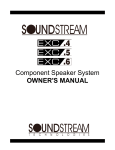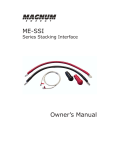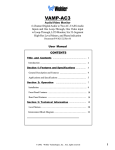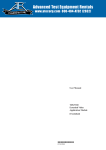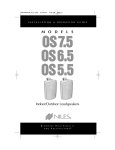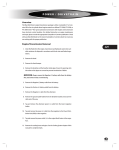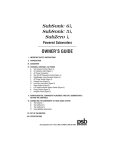Download Nokia A040 Network Card User Manual
Transcript
Nokia A040 Wireless LAN Adapter Copyright Copyright © Nokia Networks 2000, 2001. All rights reserved. Nokia is a registered trademark of Nokia Corporation, Finland. Windows 95, Windows 98, Windows 2000 and Windows NT are registered trademarks of Microsoft Corporation. MS-DOS is a registered trademark of Microsoft Corporation. Other products may be trademarks or registered trademarks of their respective manufacturers. We reserve the right to make changes and improvements to any of the products described in this guide without prior notice. Nokia is not responsible for any loss of data, income or any consequential damage howsoever caused. ISSUE 1 2 Nokia A040 Important safety information For your safety Read these simple guidelines before using your Wireless LAN Adapter. Failure to comply with these guidelines may be dangerous or illegal. Further detailed information is given in this document. Interference All wireless devices are susceptible to interference, which could affect performance. Switch off in aircraft Wireless devices can cause interference. Using them on aircraft is illegal. Switch off when refueling Do not use the Wireless LAN Adapter at a refueling point. Do not use near fuel or chemicals. Switch off near blasting Do not use the Wireless LAN Adapter where blasting is in progress. Observe restrictions, and follow any regulations or rules. Switch off near medical equipment Follow all regulations and rules in hospitals. Do not use the Wireless LAN Adapter near medical equipment. Use qualified service Only qualified service personnel must repair equipment. Accessories Use only approved accessories. Do not connect incompatible products. Make backup copies Remember to make backup copies of all important data. Connecting to other devices When connecting to any other device, read its user's guide for detailed safety instructions. Do not connect incompatible products. 3 Using this document The Wireless LAN Adapter is approved to create a wireless LAN network to send data and e-mail messages, to browse on the Internet, and to establish connections with other computers. Data connections can be made from most locations where your Wireless LAN Adapter operates. However, it is recommended that you move the Wireless LAN Adapter to a location where the strongest possible network signal can be obtained. When the signal is strong, data transmission is efficient. The following factors may impair wireless connections: Noise Radio interference from electronic appliances and equipment, as well as from other wireless devices in areas where wireless devices are prevalent. Handover As the Wireless LAN Adapter user moves from one network cell to another, the signal strength of the channel drops and the network may hand the user over to a different cell and frequency, where the signal is stronger. A cell handover may also occur when the user is stationary due to varying network traffic loads. 4 Electrostatic discharge A discharge of static electricity from a finger or a conductor may cause erroneous functions in electric devices. The discharge may result in unstable software operation. Network connections may become unreliable, data may be corrupted, and the transmission halted. In this case, end the existing connection (if any) and restart the unit by powering off and on again. Dead spots and dropouts Dead spots are areas where radio signals cannot be received. Dropouts occur when the Wireless LAN Adapter user passes through an area where the radio signal is blocked or reduced by geographic or structural obstructions. Signal impairment Distance and obstacles can cause out-ofphase reflected signals that result in a loss of signal strength. Low signal strength Due to either distance or obstacles, the radio signal strength from a network cell may not be strong or stable enough to provide a reliable wireless connection for communication. Therefore, to ensure the best possible communication, remember to consider the following points: • Data connection works best when the Wireless LAN Adapter is in a stationary position. • Do not place the Wireless LAN Adapter on a metal surface. Nokia A040 WARNING! Do not use the Wireless LAN Adapter when the use of a wireless LAN terminal is prohibited or when it may cause interference or danger. Use only the region setting appropriate for the area where the Wireless LAN Adapter is used at the present time. Using the Wireless LAN Adapter in any other region or with an incorrect region setting may be illegal. Use only accessories approved by Nokia for use with this particular Wireless LAN Adapter. The use of any other types may invalidate any approval or warranty applying to the Wireless LAN Adapter, and may be dangerous. For availability of approved accessories, please check with your dealer. Install the Wireless LAN Adapter close to an accessible mains power outlet. Avoid installing the Wireless LAN Adapter near sources of heat or in direct sunlight. Disconnect the power before relocating the unit. You can only remove power to the Wireless LAN Adapter by physically removing the power adapter from the main outlet, or by removing the low voltage power jack from the rear of the unit. Only use the power adapter that is supplied with the unit, or a manufacturer approved replacement. Use of any other adapter could be unsafe and cause damage to the Wireless LAN Adapter. The Wireless LAN Adapter is classified as an SELV (Safety Extra Low Voltage) circuit according to European Standard EN 60950 (Safety of information technology equipment). For this classification to be maintained, equipment to which the unit is connected must also be classified as SELV. Do not connect telephone equipment or wiring to the LAN port. This socket is only for use with RJ45 data connectors and the ISO/IEC 8802-3 twisted-pair Ethernet cabling system. 5 Care and maintenance Your Wireless LAN Adapter is a product of superior design and craftsmanship and should be treated with care. The suggestions below will help you to fulfil any warranty obligations and to enjoy this product for many years. When using your Wireless LAN Adapter, or any accessory: • Keep it and all its parts and accessories out of small children's reach. • Keep it dry. Precipitation, humidity and liquids contain minerals that will corrode electronic circuits. • Do not use or store it in dusty, dirty areas. • Do not store it in hot areas. High temperatures can shorten the life of electronic devices, and warp or melt certain plastics. • Do not store it in cold areas. When the Wireless LAN Adapter warms up (to its normal temperature), moisture can form inside the card, which may damage electronic circuit boards. 6 • • • • • • Do not attempt to open it. Non-expert handling of the device may damage it. Do not drop, knock or shake it. Rough handling can break internal circuit boards. Do not use harsh chemicals, cleaning solvents, or strong detergents to clean it. Wipe it with a soft, dry cloth. Do not paint it. Paint can prevent proper operation. Use only the supplied or an approved external antenna. Unauthorized antennas, modifications or attachments could damage the Wireless LAN Adapter and may violate regulations governing radio devices. If the Wireless LAN Adapter or any accessory is not working properly, take it to your nearest qualified service facility. The personnel there will assist you and, if necessary, arrange for service. Nokia A040 Operating environment Remember to follow any special regulations in force in any area and always power off your Wireless LAN Adapter whenever it is forbidden to use it, or when it may cause interference or danger. When connecting the Wireless LAN Adapter or any accessory to another device, read its user's guide for detailed safety instructions. Do not connect incompatible products. As with other mobile radio transmitting equipment, users are advised that for the satisfactory operation of the equipment and for the safety of personnel, it is recommended that the Wireless LAN Adapter should only be used in the normal operating position. Electronic devices Most modern electronic equipment is shielded from radio frequency (RF) signals. However, certain electronic equipment may not be shielded against the RF signals from your Wireless LAN Adapter. Pacemakers Pacemaker manufacturers recommend that a minimum separation of 20 cm (6 inches) be maintained between a Wireless LAN Adapter and a pacemaker to avoid potential interference with the pacemaker. These recommendations are consistent with the independent research by and recommendations of Wireless Technology Research. Persons with pacemakers should always keep the Wireless LAN Adapter more than 20 cm (6 inches) from their pacemaker when the Wireless LAN Adapter is powered on. If you have any reason to suspect that interference is taking place, power off your Wireless LAN Adapter immediately. Hearing aids Some digital wireless devices may interfere with some hearing aids. Other medical devices Operation of any radio transmitting equipment, including a Wireless LAN Adapter, may interfere with the functionality of inadequately protected medical devices. Consult a physician or the manufacturer of the medical device to determine if they are adequately shielded from external RF energy or if you have any questions. Power off your Wireless LAN Adapter in health care facilities when any regulations posted in these areas instruct you to do so. Hospitals or health care facilities may be using equipment that could be sensitive to external RF energy. Posted facilities Power off your Wireless LAN Adapter in any facility where posted notices so require. Potentially explosive atmospheres Do not use your Wireless LAN Adapter when in any area with a potentially explosive atmosphere and obey all signs and instructions. Sparks in such areas could cause an explosion or fire resulting in bodily injury or even death. Users are reminded of the need to observe restrictions on the use of radio equipment in fuel depots (fuel storage and distribution areas), chemical plants or where blasting operations are in progress. 7 Areas with a potentially explosive atmosphere are often but not always clearly marked. They include below deck on boats; chemical transfer or storage facilities; vehicles using liquefied petroleum gas (such as propane or butane); areas where the air contains chemicals or particles, such as grain, dust or metal powders; and any other area where you would normally be advised to turn off your vehicle engine. Failure to observe these instructions may lead to legal action. 8 Nokia A040 Regulatory information The Nokia Wireless LAN Adapter conforms to the following European directives: • CE Low Voltage Directive 73/23/EEC • CE EMC Directive 89/336/EEC • CE Marking Directive 93/68/EEC The Nokia Wireless LAN Adapter contains a Nokia C110 Wireless LAN Card. The Nokia C110 Wireless LAN Card conforms to the CE RTTE Directive 99/5/EEC. The user must observe the following precautions in installing and operating this device: • Operate the equipment in strict accordance with the manufacturer's instructions for the model. • Use only the power adapter supplied with the unit. • Always operate the unit with the factory-installed cover on the unit. • Make no modification to the equipment, which would affect its meeting the specified limits of the Rules. • Maintain the equipment in a satisfactory state of repair. • Use a category 5 shielded 10BaseT LAN cable of less than 3m (9.8ft) in length to ensure compliance of this unit to the limits set out in the EMC directive. 9 FCC & Industry Canada statement This device complies with Part 15 of the FCC rules. Operation is subject to the following two conditions: • This device may not cause harmful interference. • This device must accept any interference received, including interference that may cause undesired operation. This product contains a Nokia C110 Wireless LAN Card: • FCC ID: ORE-C110-C111 • CAN: 6611032096A This equipment has been tested and found to comply with the limits for a Class B digital device, pursuant to Part 15 of the FCC Rules. These limits are designed to provide reasonable protection against harmful interference in a residential installation. This equipment generates, uses and can radiate radio frequency energy and, if not installed and used in accordance with the instructions, may cause harmful interference to radio communications. However, there is no guarantee that interference will not occur in a particular installation. If this equipment does cause harmful interference to radio or television reception, which can be determined by turning the equipment off and on, the user is encouraged to try to correct the interference by one or more of the following measures: • Reorient or relocate the receiving antenna. • Increase the separation between the equipment and receiver. • Connect the equipment into an output on a circuit different from that to which the receiver is connected. • Consult the dealer or an experienced radio/TV technician for help. 10 The user must observe the following precautions in installing and operating this device: • Operate the equipment in strict accordance with the manufacturer's instructions. • Only use the power adapter supplied with the unit. • Always operate the unit with the factory installed cover on the unit. • Make no modification to the equipment, which would affect its meeting the specified limits of the Rules. • Maintain the equipment in a satisfactory state of repair. • Use a category 5 shielded 10BaseT LAN cable to ensure compliance of this unit to the Class B limits of the Rules. Nokia A040










